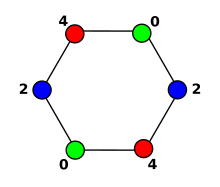
L(2, 1)-coloring or L(2,1)-labeling is a particular case of L(h, k)-coloring. In an L(2, 1)-coloring of a graph, G, the vertices of G are assigned color numbers in such a way that adjacent vertices get labels that differ by at least two, and the vertices that are at a distance of two from each other get labels that differ by at least one.
An L(2,1)-coloring is a proper coloring, since adjacent vertices are assigned distinct colors. However, rather than counting the number of distinct colors used in an L(2,1)-coloring, research has centered on the L(2,1)-labeling number, the smallest integer such that a given graph has an L(2,1)-coloring using color numbers from 0 to . The L(2,1)-coloring problem was introduced in 1992 by Jerrold Griggs and Roger Yeh, motivated by channel allocation schemes for radio communication. They proved that for cycles, such as the 6-cycle shown, the L(2,1)-labeling number is four, and that for graphs of degree it is at most .
References
- Chartrand, Gary; Zhang, Ping (2009). "14. Colorings, Distance, and Domination". Chromatic Graph Theory. CRC Press. pp. 397–438.
- Griggs, Jerrold R.; Yeh, Roger K. (1992). "Labelling graphs with a condition at distance 2". SIAM Journal on Discrete Mathematics. 5 (4): 586–595. doi:10.1137/0405048. MR 1186826.
This graph theory-related article is a stub. You can help Misplaced Pages by expanding it. |
 such that a given graph has an L(2,1)-coloring using color numbers from 0 to
such that a given graph has an L(2,1)-coloring using color numbers from 0 to  it is at most
it is at most  .
.